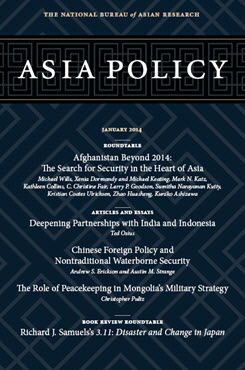The Persian Gulf States and Afghanistan
Regional Geopolitics and Competing Interests
This is one of nine essays in the roundtable “Afghanistan Beyond 2014: The Search for Security in the Heart of Asia.”,/p>
The three Persian Gulf states of Saudi Arabia, the United Arab Emirates (UAE), and Qatar have dominated the Middle East’s engagement with Afghanistan over the past three decades. This is unlikely to change as Afghanistan faces twin security and political challenges arising from the pullback of foreign troops and a presidential election in 2014. Buffeted by three years of upheaval across the Arab world, the primary objective of Saudi and Emirati officials in Riyadh and Abu Dhabi after the withdrawal of the International Security Assistance Force (ISAF) will be to prevent Afghanistan from unraveling in ways that could threaten the balance of power in the broader regional neighborhood. This reflects the fact that the Iranian shadow looms large over foreign policy formulation in Saudi Arabia and the UAE, as does a feeling of incomprehension at recent U.S. decisions on Syria and nuclear negotiations with Iran. Together, these two trends have triggered a more assertive regional policy as leaders in Riyadh and Abu Dhabi have increasingly made unilateral decisions to secure national interests. Qatari policy, by contrast, is likely to become more introspective as the new emir focuses on domestic issues and repairing diplomatic relationships damaged by his father’s foreign policy adventurism.
The Persian Gulf States and Afghanistan
In different ways, Saudi Arabia, the UAE, and Qatar have long records of involvement in Afghanistan, particularly in the post-1979 era. During the 1980s, Saudi Arabia was a key financier of the Afghan resistance to the Soviet occupation, both through official state channels and informal contributions from private citizens and charities. This occurred as the al-Saud responded to the 1979 seizure of the Grand Mosque in Mecca by Islamist militants by placing greater emphasis on what Thomas Hegghammer has labelled “alarmist pan-Islamism.” [1] Although Saudi Arabia was one of three countries (along with the UAE and Pakistan) to recognize the Taliban regime after it took power in 1996, relations frayed in 1998 when the Taliban rebuffed Saudi requests to return Osama bin Laden to the kingdom. Nevertheless, it was only after the September 11 terrorist attacks that ties were broken altogether, whereupon Riyadh gave its backing to the new Afghan government of Hamid Karzai and supported it with reconstruction assistance and direct foreign aid. [2]
As mentioned above, the UAE also extended diplomatic recognition to the Taliban regime prior to September 11. Steve Coll has recounted how, shortly after the African embassy bombings in August 1998, a U.S. retaliatory strike against a hunting camp in western Afghanistan where bin Laden was believed to be taking refuge had to be aborted after surveillance imagery indicated that high-level UAE officials, possibly including members of the ruling family, might be present. [3] A post–September 11 investigation by U.S. Treasury officials led to accusations that Dubai was a conduit for Taliban gold reserves, and small aircraft reportedly laden with gold were allegedly permitted to depart Dubai and Sharjah for Kabul and Kandahar in the days following the U.S.-led invasion of Afghanistan in October 2001. [4] Similar to Saudi Arabia, the UAE quickly switched its support to the Karzai government and by 2009 was providing 14% of its total foreign aid budget to Afghanistan. [5] Less promisingly, the collapse of the real-estate bubble in Dubai in 2008 led in part to the failure of the Da Kabul bank two years later amid persistent allegations of widespread corruption at the heart of the Karzai government (and family) that saw over $3 billion in cash being flown out of Afghanistan. Much of the money was believed to end up in Dubai either as luxury investments that subsequently turned sour during the financial crisis or to benefit from its tight banking secrecy laws. [6]
[1] Thomas Hegghammer, “Islamist Violence and Regime Stability in Saudi Arabia,” International Affairs 84, no. 4 (2008): 704.
[2] Guido Steinberg and Nils Woermer, “Exploring Iran & Saudi Arabia’s Interests in Afghanistan & Pakistan: Stakeholders or Spoilers—A Zero Sum Game?” Barcelona Centre for International Affairs, April 2013, 3, http://www.cidob.org/es/publicaciones/stap_rp/policy_research_papers/
exploring_iran_saudi_arabia_s_interests_in_afghanistan_pakistan_stakeholders_or_spoilers_a_zero_sum_game_part_2_iran.
[3] Steve Coll, Ghost Wars: The Secret History of the CIA, Afghanistan, and Bin Laden, from the Soviet Invasion to September 10, 2001 (New York: Penguin, 2004), 447–49.
[4] Christopher Davidson, “Dubai: The Security Dimensions of the Region’s Premier Free Port,” Middle East Policy 15, no. 2 (2008): 145.
[5] “UAE Has Done Exemplary Work in Afghanistan,” Gulf News, August 25, 2011.
[6] Matthew Rosenberg, “Corruption Suspected in Airlift of Billions in Cash from Kabul,” Wall Street Journal, June 25, 2010.
About Asia Policy
Asia Policy is a peer-reviewed scholarly journal presenting policy-relevant academic research on the Asia-Pacific that draws clear and concise conclusions useful to today’s policymakers. Asia Policy is published quarterly in January, April, July, and October and accepts submissions on a rolling basis. Learn more


